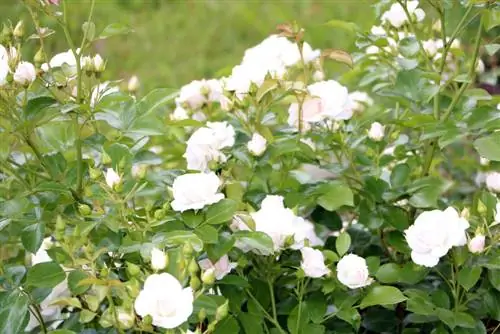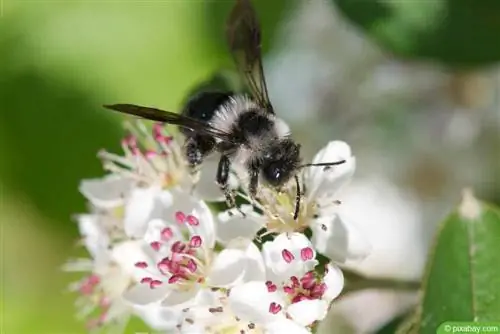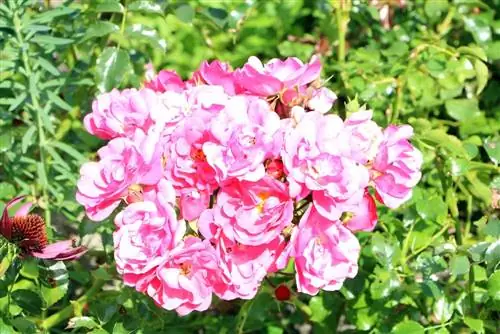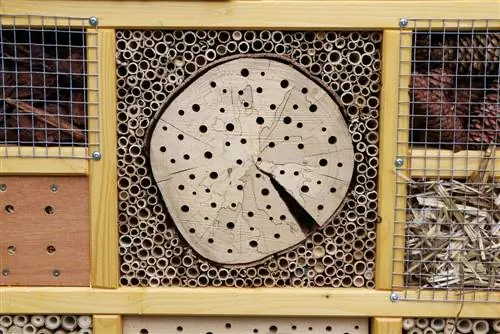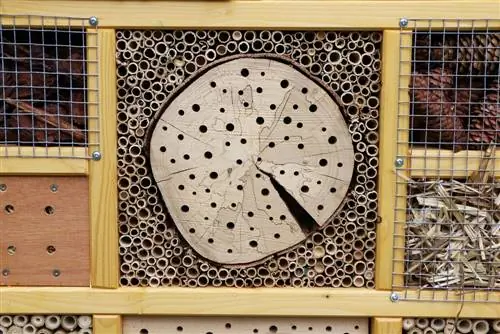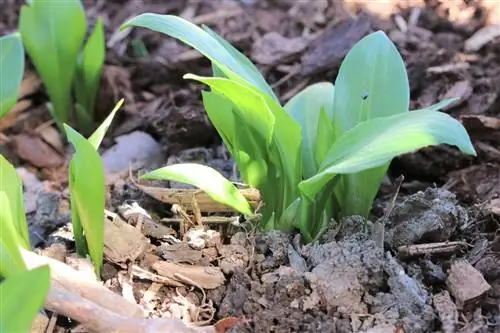- Author admin [email protected].
- Public 2023-12-17 03:39.
- Last modified 2025-01-24 12:45.
Noble roses with their tall growth and beautiful flowers are a magical eye-catcher in the garden. However, after some time - sometimes even after many years - they develop strange-looking shoots whose flowers look completely different from the original variety. These are wild shoots that definitely need to be removed - otherwise they will soon displace the noble variety. How to correctly identify and remove wild shoots.
What are wild shoots?
Noble roses are basically two plants, as these varieties were created from a wild rootstock (the so-called “wildling”) and the grafted noble rose. To do this, the breeders cut off the crown and - if it is not a standard rose - also the woody above-ground parts of the wild rose, so that only the rootstock remains. The scion is then refined and, after successful growth, it finally sprouts and develops leaves and flowers. In many cases - sometimes even after years - wild shoots appear that grow directly from the rootstock. This behavior is completely natural, after all, the rootstock is a plant that wants to develop and grow.
How can you recognize wild shoots on roses?
An old gardening wisdom says that rose shoots with five leaves are left standing, but branches with six or even seven leaves must be removed. Basically, however, this rule is only a guideline, because not all noble roses only have five leaves - some have significantly more, with six, seven or even nine leaves. A wild shoot does not always have to look significantly different from the scion, because the shape and color of the leaves also depend on the variety used - just like the shape of the spines or the hardness of the shoots.
Overview of typical characteristics of wild shoots
Since seedlings of the dog rose (Rosa canina) and the multi-flowered rose (Rosa multiflora) are often used for noble roses, you can pay attention to the following features:
- Foliage is often lighter than the noble variety
- Shoots, leaves and spines grow in a different direction
- Shoots grow noticeably faster than noble shoots
- Branches can (slightly) overhang
- white-pink or pink, simple flowers appear between June and July
Wild shoots always grow below the grafting point

The most important identifying feature, however, is this: wild shoots always grow well below the grafting point. If you are unsure whether it is a wild instinct or not, check where it originates. The grafting point is quite easy to recognize: in most varieties of noble roses it is located just above the rootstock and appears as a more or less pronounced thickening. Since the grafting site for roses should always be buried, expose the root neck to check the origin of the shoot: If the shoot comes from a place below the thickening, it is a wild shoot. If, on the other hand, it grows above, it is a scion.
Tip:
In trunk roses, the wild shoots can also sprout directly on the trunk and well above the ground. Here the grafting point is often only at the end of the trunk, as only the crown of the noble variety has been grafted onto the roots and trunk of the wildling.
Can't wild shoots also grow above the grafting site?
Now, especially with old roses, it sometimes seems as if the wild shoots are growing above the grafting point. From a botanical point of view, this is not possible, but it is easy to explain: If the rose has been in its location for a long time, the grafting area can become exposed over time - for example because rainwater washes away the soil or the gardener works the soil with a hoe or a hoe accidentally removed another garden tool. If it seems to you as if the wild shoots are sprouting from the wrong part of the plant, take a look to see whether the grafting area has been exposed. In this case, remove the wild shoots and pile up the rose so that the thickening is at least five centimeters below the surface.
Why is it important to remove wild shoots?
Remove wild shoots as quickly as possible as they
- growing stronger and faster than the noble variety
- robbing nutrients, water and light from the noble variety
- gradually displacing the noble variety
In some cases it can get to the point where the refined part of the plant is literally rejected by the strong growth of the wildling. However, the scion usually only dies gradually as the wild rootstock pushes through. Many an inexperienced gardener enjoys a supposedly two-colored rose for a few years - until one part of the plant completely replaces the other. Remember that noble varieties are always weaker and more vulnerable than wild roses. After all, that is also the reason why they are grafted onto a wild base - this is how the gardener combines beauty with robustness.
How and when do you remove wild rose shoots?
Remove wild rose shoots whenever you discover them. In this case, you don't have to stick to specific, ideal times for pruning, but you can take action at any time. First make sure whether it is actually a wild shoot and then proceed as follows:
- Expose the origin of the wild shoot, which is often located at the root collar, i.e. H. in the ground.
- Press the shoot down lightly with your thumb and, if necessary, cut it slightly and tear it off with a strong tug.
- This will also remove the so-called astring, which is a ring-shaped tumor.
- If this is not removed, the base will sprout again at this point.
- If there is a risk of major bark injuries, you can also cut.
- However, this is suboptimal as it encourages the rootstock to sprout again.
Can wild sprouting be prevented in advance?
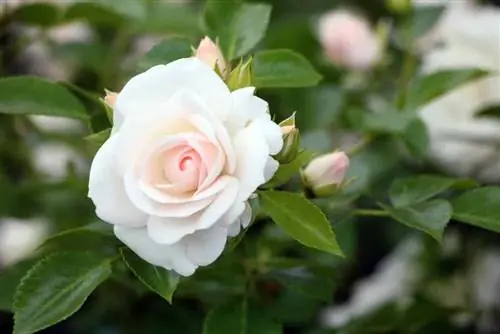
In principle, wild shoots cannot be completely avoided as they are completely natural plant behavior. However, you can curb the wild growth with a few tricks:
- Always bury the finishing point, if possible
- If possible, do not cut wild shoots, but rather tear them
- Always remove wild shoots directly at their source
- also remove the dividing tissue (the “astring”)
- Never cut wild shoots just above the ground
- then they will only grow stronger
Tip:
Since the grafting site for roses is also buried, the noble rose can also take root after a while and thus become independent of its substrate. So still look at where the supposedly wild shoot actually comes from - shoots growing from the ground can also belong to the noble variety.

